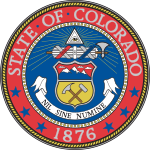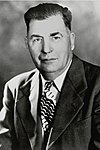
The 1924 United States presidential election was the 35th quadrennial presidential election, held on Tuesday, November 4, 1924. In a three-way contest, incumbent Republican President Calvin Coolidge won election to a full term. Coolidge was the second vice president to ascend to the presidency and then win a full term.

The 1980 United States Senate elections were held on November 4, coinciding with Ronald Reagan's victory in the presidential election. The 34 Senate seats of Class 3 were contested in regular elections. Reagan's large margin of victory over incumbent Jimmy Carter gave a huge boost to Republican Senate candidates, allowing them to flip 12 Democratic seats and win control of the chamber for the first time since the end of the 83rd Congress in January 1955.

The 1964 United States Senate elections were held on November 3. The 33 seats of Class 1 were contested in regular elections. Special elections were also held to fill vacancies. They coincided with the election of President Lyndon B. Johnson by an overwhelming majority, to a full term. His Democratic Party picked up a net two seats from the Republicans. As of 2022, this was the last time either party has had a two-thirds majority in the Senate, which would have hypothetically allowed the Senate Democrats to override a veto, propose constitutional amendments, or convict and expel certain officials without any votes from Senate Republicans. In practice, however, internal divisions effectively prevented the Democrats from doing so. The Senate election coincided with Democratic gains in the House in the same year.

In the United States Electoral College, a faithless elector is an elector who does not vote for the candidates for U.S. President and U.S. Vice President for whom the elector had pledged to vote, and instead votes for another person for one or both offices or abstains from voting. As part of United States presidential elections, each state selects the method by which its electors are to be selected, which in modern times has been based on a popular vote in most states, and generally requires its electors to have pledged to vote for the candidates of their party if appointed. A pledged elector is only considered a faithless elector by breaking their pledge; unpledged electors have no pledge to break. The consequences of an elector voting in a way inconsistent with their pledge vary from state to state.

The 2012 United States presidential election in Colorado took place on November 6, 2012, as part of the 2012 United States presidential election in which all 50 states plus the District of Columbia participated. Colorado voters chose nine electors to represent them in the Electoral College via a popular vote pitting incumbent Democratic President Barack Obama and his running mate, Vice President Joe Biden, against Republican challenger and former Massachusetts Governor Mitt Romney and his running mate, Congressman Paul Ryan. Obama and Biden carried Colorado with 51.45% of the popular vote to Romney's and Ryan's 46.09%, thus winning the state's nine electoral votes by a 5.36% margin.

The 2012 United States presidential election in New Mexico took place on November 6, 2012, as part of the 2012 United States presidential election in which all 50 states plus the District of Columbia participated. This was the 25th U.S. presidential election in which New Mexico participated. New Mexico voters chose five electors to represent them in the Electoral College via a popular vote pitting incumbent Democratic President Barack Obama and his running mate, Vice President Joe Biden, against Republican challenger and former Massachusetts Governor Mitt Romney and his running mate, Congressman Paul Ryan.

The 1948 United States Senate election in Colorado took place on November 2, 1948. Incumbent Democratic Senator Edwin C. Johnson was re-elected to third term in a landslide over Republican Will Nicholson, a businessman and Air Force veteran, winning every county in the state.

The 1942 United States Senate election in Colorado took place on November 3, 1942. Incumbent Democratic Senator Edwin C. Johnson was re-elected to second term over Republican Governor Ralph L. Carr.

The 1936 United States Senate election in Colorado took place on November 3, 1936. Incumbent Democratic Senator Edward P. Costigan did not seek a second term in office. Democratic Governor Ed Johnson won the open race to succeed him over Raymond L. Sauter.

The 2020 United States Senate election in Colorado was held on November 3, 2020, to elect a member of the United States Senate to represent the State of Colorado, concurrently with the 2020 U.S. presidential election, as well as other elections to the United States Senate, elections to the United States House of Representatives and various state and local elections.

The 2018 United States House of Representatives elections in Colorado were held on November 6, 2018, to elect the seven U.S. representatives from the state of Colorado, one from each of the state's seven congressional districts. The Republican and Democratic Party primaries in Colorado were held on June 26, 2018. The elections coincided with the gubernatorial election, as well as other elections to the House of Representatives, elections to the United States Senate, and various state and local elections.

The 1920 United States Senate election in Colorado took place on November 2, 1920. Incumbent Democratic Senator Charles S. Thomas initially declined to run for re-election, and State Supreme Court Justice Tully Scott won the Democratic nomination to succeed him, facing off against former Leadville Mayor Samuel D. Nicholson, the Republican nominee. However, in October 1920, Thomas announced that he would run for re-election as the nominee of the National Party. However, Thomas's decision did not ultimately affect the outcome of the election. Aided by Republican presidential nominee Warren G. Harding's strong performance in the state, as well as Republican Governor Oliver Henry Shoup's landslide re-election, Nicholson defeated Tully and Thomas in a landslide. Out of four candidates, Thomas placed fourth, winning just 3% of the vote and finishing behind Farmer–Labor nominee G. F. Stevens.

The 2020 United States presidential election in Colorado was held on Tuesday, November 3, 2020, as part of the 2020 United States presidential election in which all 50 states plus the District of Columbia participated. Colorado voters chose electors to represent them in the Electoral College via a popular vote, pitting the Republican Party's nominee, incumbent President Donald Trump from Florida, and his running mate Vice President Mike Pence from Indiana, against Democratic Party nominee, former Vice President Joe Biden from Delaware, and his running mate, Senator Kamala Harris from California. Colorado had nine electoral votes in the Electoral College.

The 1950 Colorado gubernatorial election was held on November 7, 1950. Republican nominee Daniel I. J. Thornton defeated Democratic incumbent Walter Walford Johnson with 52.43% of the vote.

The 1938 Colorado gubernatorial election was held on November 8, 1938. Republican nominee Ralph Lawrence Carr defeated Democratic incumbent Teller Ammons with 59.50% of the vote.

The 1936 Colorado gubernatorial election was held on November 3, 1936. Democratic nominee Teller Ammons defeated Republican nominee Charles M. Armstrong with 54.57% of the vote.

The 1932 Colorado gubernatorial election was held on November 8, 1932. Democratic nominee Edwin C. Johnson defeated Republican nominee James D. Parriott with 57.23% of the vote.

Elections were held in Illinois on Tuesday, November 5, 1940.

Elections were held in Illinois on Tuesday, November 3, 1936.

The 1932 United States Senate elections in Colorado took place on November 8, 1932. Incumbent Republican Senator Charles W. Waterman announced that he would not seek re-election to a second term. Attorney Karl C. Schuyler won the Republican nomination to succeed Waterman and faced former Senator Alva B. Adams, the Democratic nominee, in the general election.




















